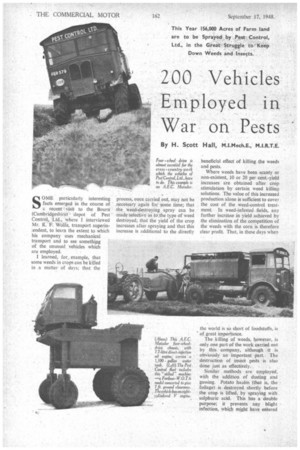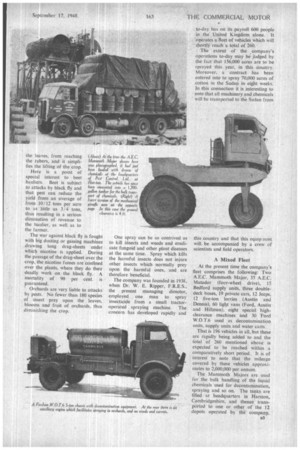200 Vehicles Employed in War on Pests
Page 36

Page 37

Page 38

If you've noticed an error in this article please click here to report it so we can fix it.
By H. Scott Hall, M.I.Mech.E., M.I.R.T.E.
SOME particularly interesting facts emerged in the course of a recent visit to the Bourn (Cambridgeshire) depot of Pest Control, Ltd., where I interviewed Mr. R. F. Wolfe, transport superin.endent, to learn the extent to which his company uses mechanical transport and to see something of the unusual vehicles which are employed.
I learned, for example, that some weeds in crops can be killed in a matter of days; that the process, once carried out, may not be necessary again for some time; that the weed-destroying spray can be made selective as to the type of weed destroyed; that the yield of the crop increases after spraying and that this increase is additional to the directly beneficial effect of killing the weeds and pests.
Where weeds have been scanty or non-existent, 10 or 20 per cent.-yield increases are obtained after crop stiMulation by certain weed killing solutions. The value of this increased production alone is sufficient to cover the cost of the weed-control treatment. In weed-infested fields, any further increase in yield achieved by the elimination of the competition of the weeds with the corn is therefore clear profit. That, in these days when the world is so short of foodstuffs, is of great importance.
The killing of weeds, however, is only one part of the work carried out by this company, although it is obviously an important Part. The destruction of .insect pestS is also
done just as effectively, Similar methods are employed, with the addition of dusting and gassing. Potato haulm (that is, the foilage) is destroyed shortly before the crop is lifted, by spraying with sulphuric acid. This has a double purpose; it prevents any blight infection, which might have entered the leaves, from reaching the tubers, and it simplifies the lifting of the crop.
Here is a point of special interest to beet hauliers. Beet is subject to attacks by black fly and that pest cart reduce the yield from an average of from 10/12 tons per acre to as little as 3/4 tons, thus resulting in a serious diminution of revenue to the haulier, as well as to the farmer.
The war against black fly is fought with big dusting or gassing machines drawing long drag-sheets under which nicotine is applied. During the passage of the drag-sheet over the crop, the nicotine fumes are 'ccinfined over the plants, where they do their deadly work on the black fly. A mortality of 90 per cent. is guaranteed.
• Orchards are very liable to attacks by pests. No fewer than 180 species of insect prey upon the leaves, blooms and fruit of orchards, thus diminishing the crop. One spray can be so contrived as to kill hisects and weeds and eradicate fungoid and other plant diseases at the same time. Spray which kills the harmful insects does not injure other insects which normally prey upon the harmful ones, and are therefore beneficial.
The company was founded in 1938, when Dr. W. E. Ripper, F.R.E.S., the present managing director, employed one man to spray insecticide from a small tractoroperated spraying machine. The concern has developed rapidly and
to-day has on its payroll 600 people in the United Kingdom alone. It operates a fleet of vehicles which will shortly reach a total of 260:
The extent of the .company's operations to-day may be jUdged by the fact that 156,000 acres are to be sprayed this year, in this country. Moreover, a contract has been entered into to spray 70,000 acres of cotton in the Sudan in eight weeks. In this connection it is interesting to note that all machinery and chemicals will he transported to the Sudan from •
At the present time the company's fleet comprises the following: Two A.E.C. Mammoth Major, 35 A.E.C. Matador (four-wheel drive), 15 Bedford supply units, three doubledeck buses, 19 private cars, 12 Jeeps, 12 live-ton lorries (Austin and Dennis). 60 leg vans (Ford, Austin and Hillman). eight special highclearance machines and 30 Ford W.O.T.6 used as decontamination units, supply units and water carts.
That is 196 vehicles in all, but these are rapidly being added to and the total of 260 mentioned above is expected to be reached within a comparatively short period. It is of interest to note that the mileage covered by these vehicles approximates to 2,000,000 per annum.
The Mammoth Majors are used for the bulk handling of the liquid chemicals used for decontamination, spraying and so on. The tanks are filled at headquarters in Harston, Cambridgeshire, and thence transported to one or other of the 12 depots operated by the company. These depots are at Holbeach, Navenby, Market Harborough. Evesham, Fakenham. Sta plehurst. Salisbury, Aylesbury, Woodbridge. Feering. Waltham (near Grimsby) and Sandtat.
A.E.C. Matador four by four" are used alternately for the conveyance of water, for which purpose they carry 1,100-gallon tanks, or for carrying liquid chemicals, when the tanks used are not quite so large.
The Bedford supply units carry 350-gallon chemical supply-tanks. They are equipped with agitation gear operated by means of a power take-off from the transmission. They also carry calibration vessel g for measuring chemicals. The chemicals are supplied to the main tanks in suitable proportions and then mixed by means of the agitation gear.
Transport for Workmen The double-deck buses are used to carry workmen from Cambridge to Bourn and back again. The private cars and the Jeeps are used by supervisors and branch managers. The vans carry spraying crews and equipment ,wherever they are required to operate.
Lorries, besides being used for ordinary haulage of all kinds of machinery, equipment and goods, are also employed to haul spraying machines from place to place.
Most interesting of all perhaps, as being unusual, are the high-clearance vehicles. These are built by County Commercial Cars, Ltd., of Fleet, Hants. and were described in detail in "The Commercial Motor" dated August 2, 1946.
Their purpose is to convey spraying apparatus for treating without damage, crops which may grow to a maximum height of 4 ft. One of the machines, however, for use in orchards and for spraying bush fruit trees and so on, has a ground clearance. of 7 ft. The cab is of the type used on the W.D. four-wheeldrive Ford. Most of the units are also common to that type of chassis. The wheelbase is 7 ft. 9 ins, and the track is adjustable from 4 ft. 6 ins. to 6 ft. 6 ins, by increments of 2 ins. This is achieved by mounting the wheels on carriers capable of sliding on tubular cross members. No adjustment is necessary to either the driving or steering mechanism, when any alteration is made to the track width.
The final drive is to the rear wheels only and is by chains from a floating axle. These chains are encased and the cases are so designed as to take the weight of the vehicle and accommodate the rear wheel bearings. The weight, without a4
spraying equipment, is 4 tons, but , addition of the spraying equipplen1 increases that weight by about 1,ton
to 25 cwt. .
The spraying machine with the 7 ft. clearance has four sets of spray pipes arranged vertically at the rear, with horizontal spray-jets. The outermost pipes have jets directed horizontally and outwardly from the machine; the spray jets on the inner two vertical pipes are directed horizontally and inwardly.
In this way, as the machine travels the rows of fruit tress, etc., spray is directed inwardly on to the fruit trees beneath the machine and outwardly to the rows of fruit trees on each side of it. It can thus be arranged if necessary. thatall the fruit trees to be sprayed have a double dose of the liquid.
A complete set of machines and crew for a spraying operation comprises a Matador, carrying water in its 1,100-gallon tank, a vehicle carrying a bulk supply of the chemicals to be used, and a tractor drawing a suitable tank with sprayer.
• Some tankers have pumps to force the solution out. The pumps may be power driven, by means of a power take-off from the transmission of the vehicle, or a small independent petrol-driven unit may he employed.
The vehicles work under difficult conditions. The maintenance costs, however, having in mind these circumstances, are not particularly high. The worst factors with which Mr. Wolfe has to contend, are petty thieving and damage to cabs, windows, windscreens and doors, the result, it would seem, of careless handling.
Another factor which increases cost of maintenance, is the fact that many of the solutions used for decontamination are acids. There is unavoidable leakage and damage results.
Maintenance Well Planned
The maintenance and service of these vehicles appear to be well organized. There is a daily service for which the driver is responsible. This comprises the usual items, i.e., check tyre-pressures, oil level in engine, lamps, wiper, speedometer, water in radiator and rate of battery charging. Each week the vehicles are washed and greased thoroughly, grease nipples being renewed when necessary, springs are sprayed, gearbox and back axle, transfer box and front-axle oil levels checked, batteries topped up, tyres inflated where necessary and stones and flints removed from treads of tyres and between twin wheels. Wheel nuts are tightened up and the speedo
meter readingtaken _ 7 As these vehicles are scattered -all over the country, being located at any of 12 depots, step must be taken to ensure that this weekly check-up is carried out without fail.. Printed cards are issued, on which all the essential operations are scheduled, these cards to be returned each week to headquarters.
There is provision on the card for items other than the ordinary weekly check, so that if any work is done on the vehicles, headquarters are immediately advised of it. A complete dossier is kept of every vehicle, showing what has been done to it from the day it was acquired, to date. An engine replacement scheme is in operation and this has been found to be particularly valuable. especially for the small vans.
Suitable Vehicles Unobtainable
Most of the vehicles are nine to 10 years old and a growing difficulty is that some of the type which have been found so useful are not now in production. An example of this is the Matador" four by four" chassis and I understand that negotiations are proceeding between the company and A.E.C., Ltd., in the hope that it will be possible for the latter concern to supply new vehicles of this type, or at least having four-wheel drive.
Some interesting data relating to inaintenance of vehicles engaged on this arduous work have been collated.
For example, a 10 h.p. Ford engine is replaced at 30,000 miles at a cost of £32 10s.
The A.E.C. oil engines do 25,000 miles before being top-overhauled. They are re-ringed and, of course, top overhauled at 50,000 miles, top overhauled again at 75,000 miles and given a= major overhaul it 100,000 miles. Apart from the foregoing. little attention is found to be necessary, in the case of the oiler.
As regards keeping track of cost of upkeep, Mr. Wolfe finds his two biggest headaches to -be tyres and batteries. New batteries may be put on vehicles which are then sent out in the normal way to work at various depots. A little later, when a checkup is made, it is found that old and dilapidated batteries have taken their place. The usual excuse is that the original battery was found to be completely discharged and another one was used to replace it A recent addition to the equipment of Pest Control, Ltd., is a loadcarrying helicopter which has been specially developed to the company's specification. A much larger helicopter is being manufactured.




















































































